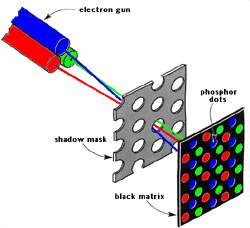| |
|
| |
| Interview Questions | |
|
Electronics Hardware Computer Software General questions Brain teasers | |
| Resources | |
|
Resume and interview How to get a job in Silicon Valley How much are you worth on market? Do you need an agent? | |
| Break time stories | |
|
Tomato company | |
| About Hitequest | |
|
About Hitequest Join us Home page | |
|
|
|
| |||||||||||||

| ||||||||||||||
|
Composite Video - also called CVBS (colour video baseband signal), contains luminance, chrominance and
sync information in one signal. Look for "Video" RCA socket on the back of your TV.
S-Video - stands for separated video: luminance and chrominance signals are transferred separately, resulting in the greater
image quality.
The special S-video connector also carries left-and-right audio signals for stereo.
Component Video (YCbCr) - video signal is devided into 3 parts:
Y - luminance signal (for compartibility with old monochrome TVs), Cb=0.564(B-Y), Cr=0.713(R-Y).
Instead of transferring 3 chrominance signals (R,G,B ) it is easier to use just their difference (save bandwidth).
Since Y is a combination of 3 major color signals, taken in the right proportion ( Y=0.587G+0.299R+0.114B),
the third color component can be extracted from Y,Cb and Cr information. This method also provides high quality
and eliminates cross-luminance and cross-color effects.
The component video requires 3 RCA connectors.
RGB - are the 3 analog inputs for a regular CRT computer monitor. Hsync and Vsync are transferred separately.
DVI - digital video interface to transmit formatted graphics data to flat-panel displays. R,G,B signals
are transferred in the digital format (8bit per signal) and accompanied by clock and control signals.
Hsync and Vsync are sent over Blue channel during the inactive data portion or blanking periods.
|
|
| ||||||||||||
